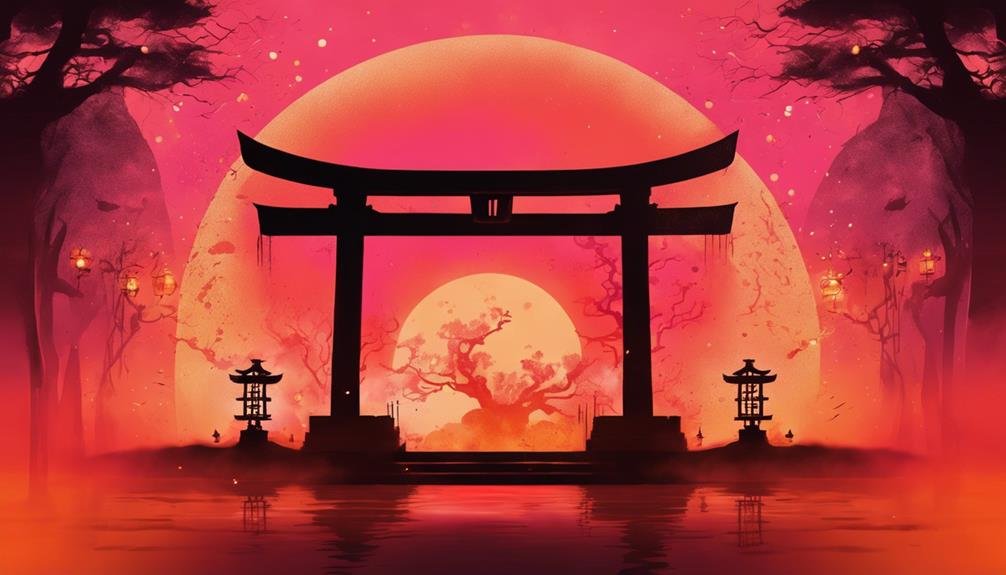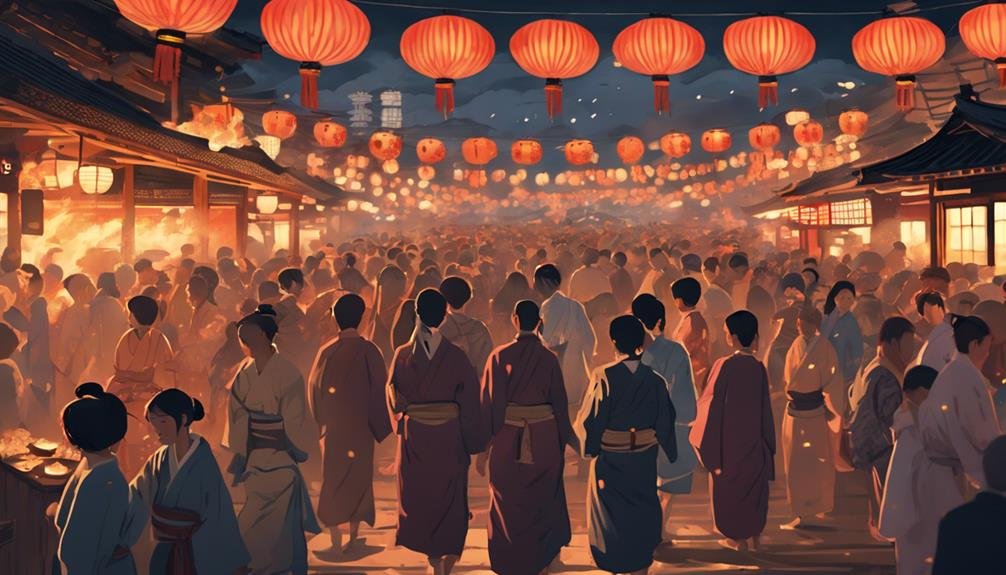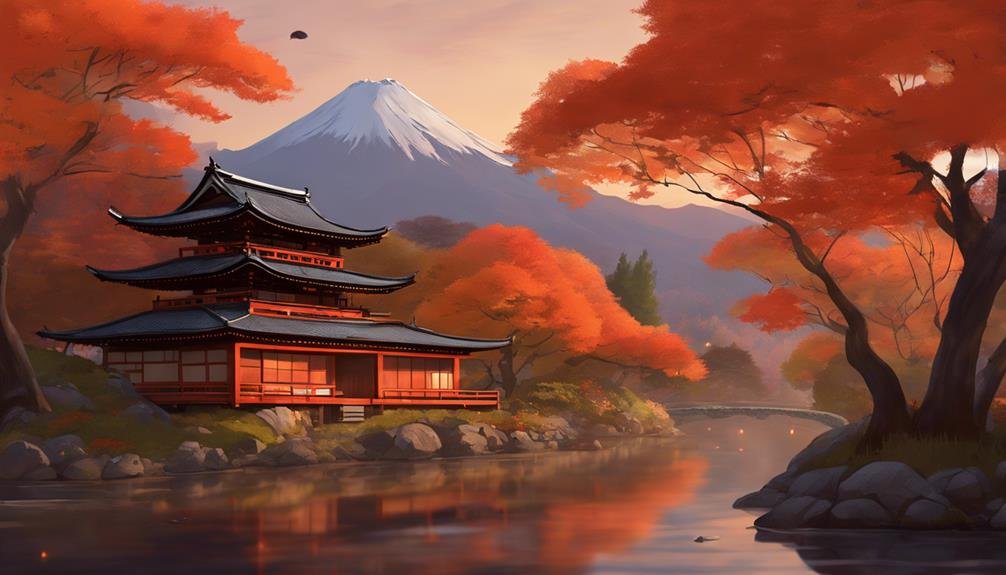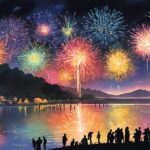As you venture into Kurama, a centuries-old Japanese village, you're about to witness a mesmerizing spectacle: the Kurama Fire Festival, where flames dance in harmony with icy winter nights. This ancient festival, rooted in Shintoism and Buddhism, is a spiritual celebration of life, energy, and renewal. You'll be captivated by the torchlight procession, fire rituals, and traditional cuisine. With careful planning, you'll soak up the pre-festival atmosphere, explore the town, and unwind in a tranquil ryokan. The flames are calling – step into the mystique of Japan's rich cultural heritage, and discover the secrets that lie beyond the fiery spectacle.
Key Takeaways
- The Kurama Fire Festival in Japan originated in the 17th century in Kyoto's Mount Kurama, where villagers paid homage to sacred flames during an epidemic.
- The fire festival symbolizes life, energy, renewal, and spiritual purification, showcasing Japan's deep connection with nature and reverence for balance.
- The festival features a torchlight procession, fire rituals, and cultural exchange, followed by a ritualistic cleansing in the icy river for spiritual purification.
- Visitors can explore Kurama Onsen, witness festival preparations, and indulge in local cuisine, including Kurama Yudofu, seasonal mochi, and grilled yakitori.
- The festival takes place in January, and visitors should pack warm clothing, comfortable shoes, and essentials, while booking accommodations in advance due to crowding.
History of the Fire Festival
As you explore the origins of the Kurama Fire Festival, you'll discover that this ancient celebration has its roots in the 17th century, when villagers in Kyoto's Mount Kurama would gather to pay homage to the sacred flames that had protected them from a devastating epidemic.
Legend has it that the fire had purifying powers, driving away evil spirits and bringing peace to the community. This folklore roots deeply in the region's cultural heritage, where fire is revered as a symbol of life, energy, and renewal.
As you investigate further, you'll uncover the ancient influences of Shintoism and Buddhism, which have shaped the festival's rituals and traditions. The fire festival's history is woven with tales of mythical creatures, deities, and heroes, adding a rich fabric of mystique to the celebration.
Today, the festival remains a tribute to the community's resilience and gratitude, as they come together to honor the sacred flames that have watched over them for centuries.
Preparing for the Big Night
With the night of the Kurama Fire Festival approaching, the villagers of Mount Kurama spring into action, transforming their quiet town into a vibrant spectacle of color and sound. As you prepare for this unforgettable experience, make sure to pack the essentials:
- Comfortable shoes for the steep mountain paths and crowded streets.
- Warm clothing for the chilly autumn evening.
- A camera to capture the breathtaking scenery and vibrant festivities.
- Snacks and water to keep your energy up throughout the night.
As you plan your travel itinerary, consider arriving in Kurama a day or two before the festival to soak up the pre-festival atmosphere. Book your accommodations in advance, as the town can get quite crowded during this time. Take some time to explore the charming town, visit the famous Kurama Onsen (hot springs), and get a glimpse of the preparations underway.
With your packing essentials in check and your travel plans in place, you're all set for an unforgettable night at the Kurama Fire Festival!
The Torchlight Procession Begins
As you stand amidst the bustling streets of Kurama, you can feel the electric energy building up around you. The torchlight procession is about to begin, and the excitement is palpable – participants are taking their positions, torches are being lit, and the night air is charged with anticipation.
It's time to experience the mesmerizing spectacle that's about to unfold.
Torchlight Parade Preparations
You step into the whirlwind of activity as villagers scramble to prepare for the Torchlight Parade, the air electric with anticipation as they carefully select and prepare the sacred torches that will soon illuminate the night sky. The atmosphere is alive with community engagement, as locals of all ages work together to make sure every detail is perfect. This is more than just a festival – it's a celebration of cultural significance, passed down through generations.
As you watch, villagers meticulously wrap the torches with sacred paper and adorn them with intricate designs. The attention to detail is impressive, and you can't help but feel the sense of pride and ownership that comes with being part of this community.
Here are just a few ways the villagers prepare for the Torchlight Parade:
- Torch selection: The villagers carefully choose the finest torches, making certain they're sturdy enough to withstand the wind and flames.
- Sacred paper wrapping: Delicate paper is wrapped around the torches, adorned with symbols and patterns that hold deep cultural significance.
- Design and decoration: The villagers add intricate designs and ornaments, making each torch a unique work of art.
- Final inspections: The villagers conduct thorough checks, making sure every torch is perfect before the parade begins.
Festival Participants Gather
The villagers, torches aglow, begin to gather at the festival grounds, their vibrant attire and beaming faces radiating excitement as the torchlight procession prepares to ignite the night. As you join the crowd, you're enveloped in the electric festival atmosphere, where the air is alive with anticipation. You can't help but feel the enthusiastic energy as the participants, adorned in traditional clothing, eagerly await the start of the procession.
As you mingle with the locals, you sense a strong cultural exchange, where visitors from around the world mingle with the Kurama villagers, all united by their enthusiasm for this ancient festival. The scent of traditional Japanese cuisine wafts through the air, further heightening your senses.
The sound of chatter and laughter fills the evening air, punctuated by the occasional drumbeat, building the anticipation for the torchlight procession to come. You can feel the excitement building, as the villagers, with their torches held high, prepare to set the night ablaze with a spectacle that will be etched in your memory forever.
Nighttime Torch Display
Flames erupt across the darkening sky as thousands of torches, held aloft by the villagers, burst into a mesmerizing display of fiery splendor, casting a golden glow over the festival grounds. You're surrounded by the warmth and energy of the crowd as the torchlight procession begins. The villagers, armed with torches, weave intricate patterns through the streets, their movements a confirmation of the ancient traditions of the Kurama Fire Festival.
As you watch, the torchlight choreography unfolds before your eyes. You notice:
- Flame patterns: Delicate swirls of fire dance across the night sky, hypnotic and mesmerizing.
- Torchlight waves: The villagers move in synchronized harmony, their torches undulating like a fiery tide.
- Flaming circles: The crowd parts to reveal a majestic circle of fire, a breathtaking display of coordination and skill.
- Blazing processions: The torchbearers weave a path through the festival grounds, their torches casting an otherworldly glow.
The night air is electric with excitement as the villagers' torches cast a spell of enchantment over the festival grounds. You're swept up in the magic of the Kurama Fire Festival, where flames and tradition come together in a dazzling display of light and movement.
Fire and Water Rituals
As drumbeats echo through the mountains, villagers clad in loincloths and headbands dash towards the icy river, ready to brave the freezing waters in a ritualistic cleansing that will purify their spirits and prepare them for the fiery spectacle to come.
You stand on the riverbank, surrounded by the villagers, and feel the chill of the winter air. The villagers, led by the high priest, wade into the icy waters, their bodies glistening with dew. This purification rite is an essential part of the Kurama Fire Festival, a ritual meant to balance the elemental forces of fire and water.
As you watch, the villagers perform a series of rituals, chanting and praying to the gods of the elements. The air is filled with the sweet scent of incense, and the sound of drums and laughter echoes through the valley. You can't help but feel a sense of wonder as you witness this ancient ritual, a manifestation of the villagers' deep connection with nature and their reverence for the elemental balance.
Meaning Behind the Flames

As you stand amidst the blazing fires of Kurama's festival, you can't help but wonder what lies beneath the fiery spectacle.
You're about to uncover the spiritual significance of fire, a symbol that has been woven into the fabric of Japanese tradition for centuries.
Get ready to unravel the mystique surrounding fire rituals, and discover how they're intertwined with the nation's rich cultural heritage.
Spiritual Significance of Fire
In the midst of Japan's Kurama Fire Festival, you stand captivated as towering flames dance across the night sky, their fiery tendrils weaving a mystical spell that whispers secrets of purification, renewal, and spiritual awakening.
As you gaze into the fiery abyss, you can't help but feel a deep sense of connection to the spiritual significance of fire. Fire has long been revered in Japanese culture as a symbol of purification and renewal.
Here are just a few ways the sacred flames are believed to transform and uplift:
- Purification rituals: Fire is thought to cleanse the body and mind of impurities, allowing participants to start anew.
- Sacred flames: The fire is believed to carry prayers and wishes to the gods, acting as a sacred messenger between the mortal and divine domains.
- Spiritual awakening: The intense heat and light of the fire are said to awaken the soul, revealing hidden truths and guiding individuals towards enlightenment.
- Renewal and rebirth: As the flames consume the old, they make way for the new, symbolizing the cyclical nature of life and death.
As you engage with the fiery spectacle, you begin to grasp the profound significance of fire in Japanese spirituality – a symbol of transformation, renewal, and the eternal cycle of life.
Fire Rituals and Tradition
You step into the fiery heart of the Kurama Fire Festival, where ancient rituals and traditions unfold like a rich mosaic, woven with threads of devotion, mysticism, and communal passion. As you submerge yourself in the vibrant atmosphere, you begin to unravel the intricate web of fire rituals and traditions that have been woven over centuries.
The fire myths of Japan's cultural heritage come alive in this sacred space, where flames symbolize purification, renewal, and spiritual awakening. You witness the reverence with which the locals approach the flames, their faces aglow with an otherworldly light.
The air is thick with anticipation as the fire rituals unfold, each movement choreographed to perfection, each gesture imbued with meaning. As you watch, mesmerized, the flames seem to dance in harmony with the rhythm of the drums, transporting you to a domain where the boundaries between reality and myth blur.
In this fleeting moment, you grasp the essence of Japan's cultural heritage – a heritage that reverberates with the pulsing heartbeat of the fire, a symbol of the nation's collective soul.
Food and Drink Delights
Indulging in the aromas wafting from steaming stalls, you'll discover a world of flavors at the Kurama Fire Festival, where sweet and savory treats await to please your senses. As you wander through the festival grounds, the enticing aromas of local specialties will lead you to the bustling food stalls.
Be sure to try these must-try treats:
- Kurama Yudofu: A local specialty made from tofu boiled in a savory broth, served with a side of rice and miso soup.
- Seasonal Mochi: Soft, chewy rice cakes filled with sweet fillings, made with seasonal ingredients like strawberries and green tea.
- Traditional Sweets: Delicate pastries and candies infused with traditional Japanese flavors like matcha and sesame.
- Grilled Yakitori: Savory skewers of marinated chicken, grilled to perfection by street vendors.
From traditional sweets to savory grilled delights, the Kurama Fire Festival is a culinary adventure waiting to happen.
Let your taste buds guide you through the vibrant stalls, and indulge in the flavors of Japan's rich culinary heritage.
Safety Precautions and Tips

As you enjoy the last bites of Kurama's culinary delights, remember to prioritize your safety amidst the festival's vibrant chaos.
With thousands of visitors flocking to the festival, crowd management is vital. Be prepared for crowded streets and narrow alleys, and stay alert to avoid getting lost or separated from your group.
In case of an emergency, know that the festival organizers have an efficient emergency response system in place, with first-aid stations and medical personnel on standby.
Practice good festival etiquette by respecting the local environment and traditions, and keep an eye on your belongings to avoid petty theft.
For personal safety, stick to well-lit areas, avoid walking alone in isolated spots, and keep your valuables secure.
Getting to Kurama Onsen
Two scenic routes converge on Kurama Onsen, a rustic hot spring village nestled in the mountains north of Kyoto, making it easily accessible by car or public transportation. As you plan your trip, you're probably wondering how to get to this charming village. Worry not, we've got you covered!
To reach Kurama Onsen, you can take the following routes:
- By Car: From Kyoto, take Route 367 north towards Kurama Onsen. The scenic drive takes around 45 minutes.
- Eizan Railway: Take the Eizan Railway from Demachiyanagi Station in Kyoto to Kurama Station. From there, it's a short 10-minute walk to the onsen village.
- JR Train: Take the JR Sagano Line from Kyoto Station to Hanazono Station, then transfer to the Kurama Line to Kurama Station.
- Bus: Take the Kyoto City Bus from Kyoto Station to Kurama Onsen. The journey takes around an hour.
Before you soak in the hot springs, don't forget to brush up on your Onsen Etiquette! Remember to wash your body before entering the hot spring, and refrain from tattoo exposure.
Now that you know how to get to Kurama Onsen, you can focus on what really matters – relaxing in the natural hot springs and enjoying the stunning scenery.
Accommodations for Visitors

You'll find a range of accommodations in Kurama Onsen, from rustic ryokans to modern hotels, all designed to help you unwind in style after a day of exploring the village and its natural hot springs.
As you wander through the village, you'll stumble upon charming local hotels, each with its own unique character. For a truly immersive experience, opt for a traditional ryokan, where you can soak up the atmosphere and indulge in delicious local cuisine.
If budget is a concern, don't worry – there are plenty of intimate guesthouses to choose from, as well as modern hostels. Whatever your style, you'll find a place to rest your head and recharge for another day of adventure in Kurama Onsen.
As you settle in, take a moment to appreciate the tranquil surroundings and let the stresses of everyday life melt away. With comfortable accommodations and breathtaking scenery, you'll be ready to take on the Kurama Fire Festival with energy and enthusiasm.
Frequently Asked Questions
Are Pets Allowed to Attend the Kurama Fire Festival?
When attending festivals, you wonder if your furry friend can join the fun. Sadly, pet safety is a top concern, and festival rules often prohibit pets to guarantee everyone's well-being, a consideration all pet owners and animal lovers should respect.
Can I Bring My Own Torch or Firework to the Festival?
You can't bring your own torch or firework to the festival; it's a safety hazard! Festival organizers have strict Torch Regulations in place to guarantee Festival Safety, so leave your sparklers at home and enjoy the sanctioned flames instead.
Are There Any Discounts or Free Admissions for Children?
You're wondering if you can score some family-friendly deals! Yes, many festivals offer kid-friendly perks, like discounts or free admission for little ones, making it a fun, affordable day out for the whole crew!
Can I Take Pictures With the Festival Performers and Participants?
When capturing festival moments, you'll want to respect cultural etiquette and photographer etiquette. Ask performers for permission before snapping photos, and seize photo opportunities amidst the vibrant festival atmosphere. Adjust your camera settings to freeze the excitement!
Are There Any ATMS or Currency Exchange Services Available Nearby?
As you navigate the vibrant festival grounds, you'll find convenient access to ATMs and currency exchange services, ensuring you have cash for local treats and souvenirs, thanks to well-planned festival logistics and local banking convenience.
Conclusion
As you stand amidst the fiery spectacle, the roar of the flames and the chanting of the priests echo through the night air, sending shivers down your spine.
The sweet scent of sake and grilled food wafts through the crowds, teasing your senses.
You're now a part of Kurama's ancient tradition, where fire and water unite in a mesmerizing dance.
Let the flames ignite your spirit, and let the magic of this Japanese winter night stay with you forever.



